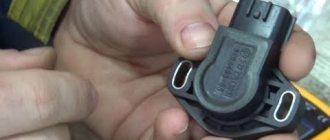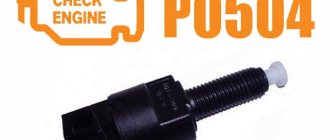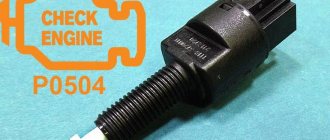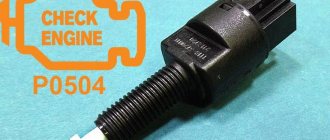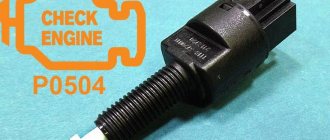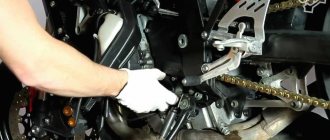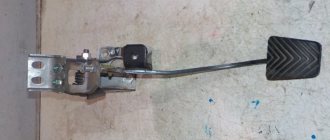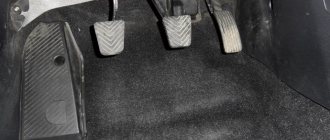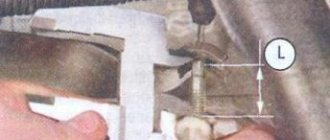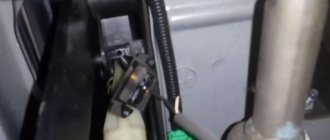Owners of LADA cars with an electronic gas pedal may encounter error P0504 (mismatch of brake pedal sensors). Along with it, malfunctions in the engine may appear (stalls, speed fluctuates, does not start, etc.). Most often the cause is the brake pedal position sensor (brake light sensor or frog).
The brake pedal position sensor and brake light switch are mounted in one housing. Most often, the cause of its malfunction is a broken spring. In this case, you can repair the sensor yourself by replacing the spring with a new one. Or replace the sensor with a new one.
What are the reasons that cause sensor failure?
A detailed examination of the essence of the problem that arose, when error code 0504 appeared, will allow us to determine the list of reasons. This refers to the disassembly of the ill-fated sensor in the LADA Granta car. Three clips serve as an obstacle to this noble procedure, preventing the component from being easily disassembled. After overcoming this “barrier”, it becomes possible to observe the real reasons that caused the breakdown:
- deformation of the smaller (of 2) springs located on the rod;
- different heights of the contacts of the designated sensor;
- poor material (steel) used for the manufacture of terminals;
- presence of play on the floating contact element.
“Ringing” can be used as the initial stage of diagnosis. Each of the contacts must be subjected to this action separately, and then in pairs (“2nd” with “3rd”). The experience of LADA Granta owners indicates the presence of a dull tone during ringing, which confirms the malfunction of the contact group. Serviceable contacts are characterized by a distinct ringing “squeak”.
Magnetic sensor
Many users may assume that the magnetic type sensor is equipped with a reed switch. For those who don’t know what a reed switch is, I’ll explain. This is an abbreviation for “sealed contact” - an electromechanical device consisting of a sealed bulb with a pair of contacts located in it. When this device is in a magnetic field, the contacts close, and when the field disappears, the contacts open.
Reed switch
So, the reed switch, like any mechanism, wears out and becomes unusable. It is for this reason that it was replaced by Hall sensors (HL). Such a sensor is activated when it is in a magnetic field. It has three pins: “+5V”, “GND” and signal. “+5V” and “GND” - power supply to the sensor, while the output signal comes from the signal one. The wires stretch from the DC to the control unit.
Hall Sensor
The advantage of DH is reliability! If the structure is assembled with high quality, it will last for a very long time. But the disadvantages include the need for another power cable to the sensor and the use of an additional element, the role of which is played by a magnet.
To activate the DC, a magnet must pass by it. This is where an interesting question arises: how to firmly fix the sensor and magnet on the brake lever, so that when the lever moves, the magnet moves over the sensor?
Here we have the most popular brake sensor on Aliexpress. In addition to the sensors themselves, the kit comes with magnets and high quality double-sided tape from.
So, the seller himself advises mounting the equipment in this way: we glue the sensor body to the brake trigger body, and the magnet, in turn, is glued to the handle itself.
The image shows this very variation of the installation
Looks good - doesn't it? But not everything is so rosy! Reviews from cyclists about this equipment are not entirely positive. In one case, the user installed a magnet not from this set, fixing it on a plate made of metal and pressing it to the handle using ties.
In another situation, the sensor and magnet were installed as prescribed by the manufacturer, but in addition they were reinforced with ties. However, if you pay attention to the gap between the magnet and the sensor, it turns out that such a circuit is unlikely to function adequately.
Nylon clamps are bad because they lose their elasticity along the way and eventually break. Naturally, this must be taken into account.
There is a company in Russia that produces e-bikes; specialists also develop and manufacture brake sensors for hydraulic brakes. This company is called Electronbikes. The DCs they produce are located inside a housing made of anodized aluminum, firmly fixed to the brake handle. The magnet is fixed to the rod by means of a transition element.
This is their brake sensor on the Avid Elixir 9 Trail. Anodic oxidation has not yet been carried out.
Screw-type connections give the device a fairly high degree of reliability, and after the anodizing procedure, when the assembly becomes black, such a product should look quite solid.
A couple more of their developments: Avid Elixir 1 (first image) and Hayes Nine (second image).
How to replace the sensor?
If you have received error code 0504, to perform this simple procedure you will need to provide access to the pedal bracket on the Lada Granta, on which our “ill-fated” sensor is actually present, or rather, above the pedal assembly. A well-carried out replacement will guarantee long-term operation.
- Remove the negative terminal from the battery terminal.
- We press out the plastic retainer (use a screwdriver).
- Next, remove the block with wires.
- Turn the sensor in a clockwise direction.
- We remove the faulty part.
We install the new component on a Lada Granta car in the reverse order. Don’t forget to first release the pedal to be able to insert the new product into its socket. We turn the component against the direction of the arrow until the corresponding click appears.
Push button sensor
This is the most common type of brake sensor today, designed in the form of a simple button that closes or opens two contacts when the brake is applied. It can be found in the handles that come in the same set with Bafang mid-drive.
Brake trigger included with the Bafang kit
In such a mechanism, when the lever is acted upon, two wires will be closed, reaching to the electric bike’s control unit. The same button is located inside the handle, but if we look closely at the sealed connector of the device under discussion, we will see that there are actually not two contacts, but one more. Where does the 3rd contact come from and what is its purpose?
The whole secret is that there is another type of brake sensors, which operates according to a three-wire circuit. The developers of the device used a three-pin connector for versatility, making it possible to connect others instead of these brake levers, those that operate on a three-wire circuit. We will consider them in the next section.
So, how can the push-button design please the owner of an electric bicycle? Obviously - due to its simplicity! But the disadvantage lies in the fact that the button, like any mechanical component, will gradually wear out and fail.
Some do-it-yourselfers assemble brake sensors based on microswitches, but these products generally cannot boast of a high degree of reliability and, moreover, they do not look very attractive.
About alternative sensor options
Since domestic “devices” for the Lada Granta car are not able to prevent an unpleasant situation, it is possible to use other devices that act as analogues. Such a component could be a brake light switch from Volkswagen, or more precisely: “FACET 7.1126”. This switch is slightly more expensive than the “native” one (560 rubles) and has the following features:
- four contacts;
- threaded leg with a similar diameter of 12 mm.
To successfully install the indicated analogue, you will need to acquire an adapter for the terminals.
Owners of LADA cars with an electronic gas pedal may encounter error P0504 (mismatch of brake pedal sensors). Along with it, malfunctions in the engine may appear (stalls, speed fluctuates, does not start, etc.). Most often the cause is the brake pedal position sensor (brake light sensor or frog).
The brake pedal position sensor and brake light switch are mounted in one housing. Most often, the cause of its malfunction is a broken spring. In this case, you can repair the sensor yourself by replacing the spring with a new one. Or replace the sensor with a new one.
Purpose of brake sensors
Imagine this situation: you rode an electric bike to some public event, met with friends, slowed down and started communicating with them, but you forgot to turn off your electrified iron horse. Here, at some point, one of your friends approached your device, who had never dealt with such equipment before and, for fun, decided to twist the gas handle, completely unaware of the consequences of these manipulations. Naturally, the two-wheeled product will start moving.
You also did not expect such a whim of fate, so you can either fall yourself or crash into a citizen who is serenely positioned in your path.
A similar situation can happen to a rider if he is stopped at a crossing, waiting for the right moment when he can cross, and someone accidentally, or maybe the cyclist himself, touches the pedal of the electric bike, which triggers the PAS sensor. The device will move onto the roadway, probably together with the rider, and the more power the unit has, the more unpredictable the outcome of the unexpected maneuver will be.
Just so that such extreme misunderstandings do not arise, sensors are mounted on the brake levers that allow, even with a weak impact on the brake control, to turn off the power supply to the power unit. This saves battery power and also prevents unnecessary overloading of the bicycle’s electric motor during braking.
Another purpose of brake sensors is to enable recuperation (if provided) on electrified bicycles and motorcycles with direct drive engines.
Well, next, we will discuss the types of brake sensors.
How to remove and install
Disconnect the negative terminal of the battery. Move the driver's seat as far back as possible, lift the steering column up, and remove the carpet. The sensor is located near the brake pedal, to remove it you need to remove the block with wires (by snapping the latches), and then:
- (Priora, Kalina, Granta, Niva 4x4) loosen the lock nut and unscrew the sensor.
- (Largus, Vesta, XRAY) turn the sensor counterclockwise 90 degrees and remove it from the bracket.
Installation of the brake pedal sensor is carried out in reverse order. Adjust it if necessary. We tighten the sensor until the pedal goes down. Then turn it out a little (counterclockwise 90 degrees) and secure with a lock nut. It should be so that when the brake pedal is released, the switch rod is completely “recessed”, and when the pedal is pressed, the rod should completely come out of the switch body. The process of removing and installing the sensor is also shown in the video:
Removal and installation
Replacing the brake pedal sensor on Kalina is carried out using an adjustable wrench set to “19”. The sensor itself is located above the brake pedal under the steering column. Conventionally, the removal stages can be divided into 5 steps:
- Before starting electrical work, it is recommended to disconnect the negative wire (terminal) from the battery.
- Then you need to move into the car interior on the driver’s side. For ease of operation, it is advisable to move the driver's seat in the opposite direction from the dashboard.
- Find the location of the sensor. Find a contact chip with wires. Press and hold the 2 plastic fasteners located on both sides of the chip. Pull the connector out of the sensor connector.
- Take the wrench in your hands and loosen the fastening nut. After which the sensor can be unscrewed freely.
- The installation process is similar to the removal procedure, except that you will need to make adjustments (tuning), the process of which is described in detail in the previous section.
How to check
Turn on the ignition and press the brake pedal, the brake lights should light up. After releasing the pedal they should go out. If the lamps do not light up, check the brake pedal sensor and the voltage supply from the battery to the wiring harness block.
(Largus, Vesta, XRAY) Move the rod lock to the right position using a screwdriver. We check the brake pedal sensor using a multimeter in ohmmeter mode. Circuit 3-4 should be closed (resistance value is close to zero), and circuit 1-2 should be open (resistance should tend to infinity). After pressing the rod, circuit 3-4 should open, and circuit 1-2 should close. Before installation, move the rod to the left position.
(Priora, Kalina, Granta, Niva 4x4) Circuit 1-4 should be closed, and circuit 2-3 should be open. After pressing the rod, circuit 2-3 will close, and circuit 1-4 will open.
Hi all. Today we'll talk about the brake pedal sensor, or brake pedal position sensor to be precise. You will learn about the weak points of this device, as well as how to repair the brake pedal sensor or replace it on a Lada Granta.
Connection to control unit
The brake sensors mentioned in the topic are equipped with a sealed connector at the end of the wire, usually intended for joining with the integration cable (below in the photo). It is present in the Bafang mid-drive set.
Using a cable, the brake control sensors are connected to a control unit located in the housing of the central power unit.
The option with an integration cable makes it possible to simplify repair work and maintenance. For example, if there is a need to replace the brake lever, accelerator handle or monitor, you can simply unplug the connector on the steering wheel, rather than pulling out the entire cable going to the control device.
If you purchase an inexpensive set with MK, most likely you will get Wuxing handles equipped with extended wires and leaky connectors at the end. Such a device will not have the best effect on the aesthetic component of the electric bike, due to the presence of a large amount of wiring, and you should not count on easy diagnostics and simplified repair measures during the operation of the vehicle.
So, let's make connections. The control unit has a pair of connectors for connecting brake sensors. It is not difficult to distinguish them - they are connected in parallel. If we take into account the integration cable, then this connection is located on the steering wheel, and not four wires go to the control device in the cable, but two.
However, what should we do if we do not have a two-wire system with a button sensor, but a three-wire system with a DC sensor? Where can I find the 3rd wire? In reality, there is nothing complicated here: the 3rd wire is the DC power supply - voltage +5 V. It can be safely taken from the DC power supply mounted on the accelerator handle. It is slightly different there, but it is also powered by +5 V.
We need to find the accelerator handle connector according to the instructions for the control device from the kit you purchased. Next, we look for a contact with a voltage of +5 V on it and solder in parallel the wire used as the missing contact on the brake sensor connectors.
Removing and repairing the brake pedal position sensor
1. To diagnose the problem, it is necessary to remove the brake pedal sensor. This is done using the key at “19”. Move the driver's seat back and find the desired sensor. Then loosen the nut, turn off the power and remove the brake pedal sensor.
2. Then we disassemble it. Disassembly is quite simple; the sensor consists of two parts and is held on by latches. There is a spring inside the sensor, which most often causes a malfunction.
3. Replacing a spring with a suitable size and number of turns in most cases solves the problem. Also look at the condition of the contacts; there should be no oxides on them, and they should not be burnt.
4. After repairing the brake pedal position sensor, assemble it in the reverse order. And we install it in place.
5. Next, you need to adjust the sensor; for this there are two nuts on it at the top and bottom. The top one adjusts the gap, which determines the correct stroke of the button. The challenge is to find the “sweet spot” and adjust the gap so that the button moves freely.
6. Now that the Grant brake pedal sensor has been repaired, installed and adjusted, you can check its operation, but before that you should reset the error.
7. Then we start the engine and let it run, it may take about 10-15 minutes, if during this time the ECU does not generate an error, then the repair was not in vain. If the error appears again, it means something is wrong with the sensor, or it is incorrectly adjusted. If after all the manipulations you still have not managed to solve the problem with error P0504, most likely you will have to buy a new brake pedal position sensor and install it.
«>
Error in brake sensor signal on grant
Welcome to ChipTuner Forum.
Theme Options
wryip
anatoli
wryip
wryip
I didn’t adjust it on the grant, but maybe this instruction will be useful or you’ll find something similar when adjusting
Adjusting the brake pedal switches:
Connect the scanner, turn on the ignition. Check the parameters: the state of normally open switch 1 and the state of normally closed switch 2. When the brake pedal is pressed, the switches should move from the “NO” state to the “IS” state in the sequence: first No. 2 = IS, then No. 1 = IS. If, when the brake pedal is not pressed, switch 2 is in the “IS” state or when you lightly touch the pedal it goes into this state, then it is necessary to adjust the switch using the adjusting nut to the “NO” state, that is, “press” switch 2 to the pedal in order to eliminate possible “blinking” of the switch when the pedal plays when it is not pressed. Reset the error codes, turn on the ignition again, press the brake pedal 3-5 times and check for their presence. Please note that if there is an error due to an incorrect signal from the brake pedal position sensor, the malfunction lamp does not light up.
electromechanic
Fedorov
I didn’t adjust it on the grant, but maybe this instruction will be useful or you’ll find something similar when adjusting
Adjusting the brake pedal switches:
Connect the scanner, turn on the ignition. Check the parameters: the state of normally open switch 1 and the state of normally closed switch 2. When the brake pedal is pressed, the switches should move from the “NO” state to the “IS” state in the sequence: first No. 2 = IS, then No. 1 = IS. If, when the brake pedal is not pressed, switch 2 is in the “IS” state or when you lightly touch the pedal it goes into this state, then it is necessary to adjust the switch using the adjusting nut to the “NO” state, that is, “press” switch 2 to the pedal in order to eliminate possible “blinking” of the switch when the pedal plays when it is not pressed. Reset the error codes, turn on the ignition again, press the brake pedal 3-5 times and check for their presence. Please note that if there is an error due to an incorrect signal from the brake pedal position sensor, the malfunction lamp does not light up.
Source
Causes of malfunction and their consequences
If there is an external or internal breakdown of the sensor on the Granta dashboard, the “Check Engine” will light up with error “P0504”. This error indicates a malfunction of the DPT.
Symptoms of a problem
- The car starts poorly and immediately stalls;
- The idle speed fluctuates;
- The motor does not develop the required power;
- Jerks when moving;
Reasons for failure
- The main cause of DPT failure is the spring, which returns the sensor contacts to their original position. If the spring breaks, the contacts do not return and remain in the final position, thereby the ECU continues to receive a signal that the car is braking and thus does not allow it to develop the necessary speed to complete the maneuver.
- A less common breakdown is the failure of the sensor housing, since the sensor is made of plastic, when removing or replacing it it is easy to damage it, which can harm its design and operating mechanisms.
- And the last reason is carbon deposits on the contacts. When the sensor is used for a long time, electrical deposits appear on its contacts, which soon leads to a poor connection between the moving contact and the fixed one.
FAQ
How many brake pad sensors are there in BMW?
- Typically two. One sensor is located on one front brake pad (front left). The second wear sensor is located on the right rear brake pad
What is the resistance of BMW brake pad sensor?
- New brake pads: zero resistance (or closed circuit).
- Worn pads: Infinite resistance (open circuit) when the pads (sensor) are worn.
Where is the BMW brake pad sensor located? ?
- Front left brake caliper. Installed on the brake pad.
- Rear right brake caliper. Installed on the brake pad.
Related articles:
- How to replace Mercedes-Benz brake wear sensor
- BMW brake light reset instructions
- Symptoms of bad brake pads
- BMW brake reset failed
- How to replace rear brake pads on a BMW
- How to replace rear brake pads on a BMW
